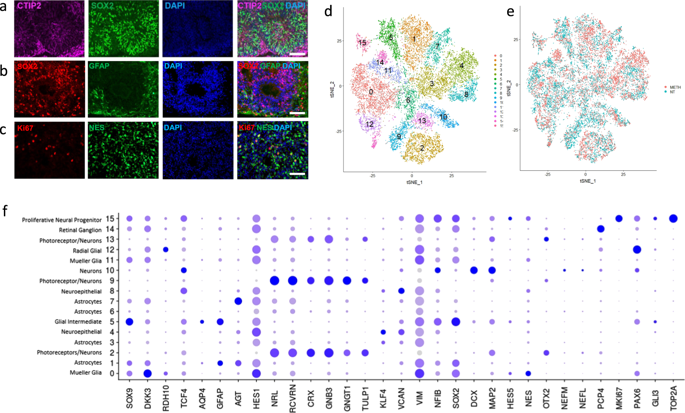当前位置:
X-MOL 学术
›
Mol. Psychiatry
›
论文详情
Our official English website, www.x-mol.net, welcomes your feedback! (Note: you will need to create a separate account there.)
Glial cell diversity and methamphetamine-induced neuroinflammation in human cerebral organoids.
Molecular Psychiatry ( IF 11.0 ) Pub Date : 2020-02-12 , DOI: 10.1038/s41380-020-0676-x Jason Dang 1 , Shashi Kant Tiwari 1 , Kriti Agrawal 1, 2 , Hui Hui 1, 2 , Yue Qin 1, 2 , Tariq M Rana 1
Molecular Psychiatry ( IF 11.0 ) Pub Date : 2020-02-12 , DOI: 10.1038/s41380-020-0676-x Jason Dang 1 , Shashi Kant Tiwari 1 , Kriti Agrawal 1, 2 , Hui Hui 1, 2 , Yue Qin 1, 2 , Tariq M Rana 1
Affiliation

|
Methamphetamine (METH) is a potent stimulant that induces a euphoric state but also causes cognitive impairment, neurotoxicity and neurodevelopmental deficits. Yet, the molecular mechanisms by which METH causes neurodevelopmental defects have remained elusive. Here we utilized human cerebral organoids and single-cell RNA sequencing (scRNA-seq) to study the effects of prenatal METH exposure on fetal brain development. We analyzed 20,758 cells from eight untreated and six METH-treated cerebral organoids and found that the organoids developed from embryonic stem cells contained a diverse array of glial and neuronal cell types. We further identified transcriptionally distinct populations of astrocytes and oligodendrocytes within cerebral organoids. Treatment of organoids with METH-induced marked changes in transcription in multiple cell types, including astrocytes and neural progenitor cells. METH also elicited novel astrocyte-specific gene expression networks regulating responses to cytokines, and inflammasome. Moreover, upregulation of immediate early genes, complement factors, apoptosis, and immune response genes suggests a neuroinflammatory program induced by METH regulating neural stem cell proliferation, differentiation, and cell death. Finally, we observed marked METH-induced changes in neuroinflammatory and cytokine gene expression at the RNA and protein levels. Our data suggest that human cerebral organoids represent a model system to study drug-induced neuroinflammation at single-cell resolution.
中文翻译:

人脑器官中的神经胶质细胞多样性和甲基苯丙胺诱导的神经炎症。
甲基苯丙胺(METH)是一种有效的兴奋剂,可诱发欣快状态,但也会引起认知障碍,神经毒性和神经发育缺陷。然而,METH引起神经发育缺陷的分子机制仍然难以捉摸。在这里,我们利用人脑类器官和单细胞RNA测序(scRNA-seq)研究了产前METH暴露对胎儿脑发育的影响。我们分析了八种未经处理和六种经METH处理的大脑类器官的20,758个细胞,发现从胚胎干细胞发育而来的类器官包含多种胶质和神经元细胞类型。我们进一步确定了脑类器官内星形胶质细胞和少突胶质细胞的转录不同群体。用METH诱导的多种细胞类型的转录显着变化处理类器官,包括星形胶质细胞和神经祖细胞。METH还引发了新的星形胶质细胞特异性基因表达网络,调节对细胞因子和炎症小体的反应。此外,立即早期基因,补体因子,细胞凋亡和免疫反应基因的上调提示由METH诱导的神经炎症程序调节神经干细胞的增殖,分化和细胞死亡。最后,我们在RNA和蛋白质水平观察到了METH引起的神经炎症和细胞因子基因表达的明显变化。我们的数据表明人脑类器官代表了一个模型系统,以单细胞分辨率研究药物诱导的神经炎症。立即早期基因,补体因子,细胞凋亡和免疫反应基因的上调表明由METH诱导的神经炎症程序调节神经干细胞的增殖,分化和细胞死亡。最后,我们在RNA和蛋白质水平上观察到了明显的METH诱导的神经炎症和细胞因子基因表达的变化。我们的数据表明人脑类器官代表了一个模型系统,以单细胞分辨率研究药物诱导的神经炎症。立即早期基因,补体因子,细胞凋亡和免疫反应基因的上调表明由METH诱导的神经炎症程序调节神经干细胞的增殖,分化和细胞死亡。最后,我们在RNA和蛋白质水平上观察到了明显的METH诱导的神经炎症和细胞因子基因表达的变化。我们的数据表明人脑类器官代表了一个模型系统,以单细胞分辨率研究药物诱导的神经炎症。
更新日期:2020-02-12
中文翻译:

人脑器官中的神经胶质细胞多样性和甲基苯丙胺诱导的神经炎症。
甲基苯丙胺(METH)是一种有效的兴奋剂,可诱发欣快状态,但也会引起认知障碍,神经毒性和神经发育缺陷。然而,METH引起神经发育缺陷的分子机制仍然难以捉摸。在这里,我们利用人脑类器官和单细胞RNA测序(scRNA-seq)研究了产前METH暴露对胎儿脑发育的影响。我们分析了八种未经处理和六种经METH处理的大脑类器官的20,758个细胞,发现从胚胎干细胞发育而来的类器官包含多种胶质和神经元细胞类型。我们进一步确定了脑类器官内星形胶质细胞和少突胶质细胞的转录不同群体。用METH诱导的多种细胞类型的转录显着变化处理类器官,包括星形胶质细胞和神经祖细胞。METH还引发了新的星形胶质细胞特异性基因表达网络,调节对细胞因子和炎症小体的反应。此外,立即早期基因,补体因子,细胞凋亡和免疫反应基因的上调提示由METH诱导的神经炎症程序调节神经干细胞的增殖,分化和细胞死亡。最后,我们在RNA和蛋白质水平观察到了METH引起的神经炎症和细胞因子基因表达的明显变化。我们的数据表明人脑类器官代表了一个模型系统,以单细胞分辨率研究药物诱导的神经炎症。立即早期基因,补体因子,细胞凋亡和免疫反应基因的上调表明由METH诱导的神经炎症程序调节神经干细胞的增殖,分化和细胞死亡。最后,我们在RNA和蛋白质水平上观察到了明显的METH诱导的神经炎症和细胞因子基因表达的变化。我们的数据表明人脑类器官代表了一个模型系统,以单细胞分辨率研究药物诱导的神经炎症。立即早期基因,补体因子,细胞凋亡和免疫反应基因的上调表明由METH诱导的神经炎症程序调节神经干细胞的增殖,分化和细胞死亡。最后,我们在RNA和蛋白质水平上观察到了明显的METH诱导的神经炎症和细胞因子基因表达的变化。我们的数据表明人脑类器官代表了一个模型系统,以单细胞分辨率研究药物诱导的神经炎症。



























 京公网安备 11010802027423号
京公网安备 11010802027423号